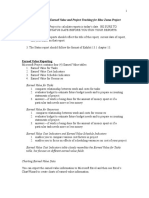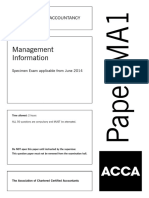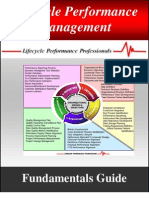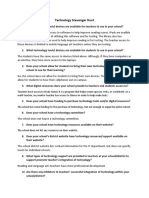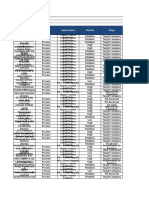STUMP Earned Value Exercise
STUMP Earned Value Exercise
Uploaded by
Nevets NonnacCopyright:
Available Formats
STUMP Earned Value Exercise
STUMP Earned Value Exercise
Uploaded by
Nevets NonnacCopyright
Available Formats
Share this document
Did you find this document useful?
Is this content inappropriate?
Copyright:
Available Formats
STUMP Earned Value Exercise
STUMP Earned Value Exercise
Uploaded by
Nevets NonnacCopyright:
Available Formats
General Application
Case Study
Earned Value
Project Background
To maintain their competitive position in the robotics market, STUMP Corp need to develop a new generation robot. They have initiated a project to achieve this goal. The project starts on 1st January 2000. The project is comprised of the tasks listed in Table One below. Predecessors, task duration and the number of personnel required to achieve the task in that duration are also provided.
Part 1: Requirements
Construct a Bar chart for the project and determine the Budget At Completion (BAC) for the project. Assume that STUMP have access to unlimited resource; that personnel cost $10,000 per month per person, and that there are no project costs other than personnel costs. A task cannot commence until all its predecessors have been completed. ID A B C D E F G H I Job Description Electrical Design Assemble Boards Test Boards Software Design Programming Software Testing Robot Body Design Robot Construction Final Assembly Immediate Predecessors Start A B Start D E A G C,F,H Planned Duration (Months) 4 4 2 4 2 2 4 2 2 Staff 6 3 2 1 2 2 2 2 2
Table One: Original Task List and Budgeted Effort
(c) Harrison International Ltd, 2000. All rights reserved.
Page 1 of 5
General Application
Case Study
Model Answer For Part 1
Month
Task Electrical Design Assemble Boards Test Boards Software Design Programming Software Testing Robot Body Design Robot Construction Final Assembly 01 02 03 04 05 06 07 08 09 10 11 12 01 02 03
Table Two: Original Gantt Chart BAC = $680,000 i.e. sum(duration(i) x staff(i)) for all i, where i = a project task.
Part 2: Earned Value Calculations
After 8 months project progress is detailed in Table Three. Predecessors remain the same. ID Job Description Effort to Date (Person Months) 30 9 0 4 8 0 6 0 0 Outstanding Duration (Months) 0 1 2 0 1 4 1 2 2 Staff
A B C D E F G H I
Electrical Design Assemble Boards Test Boards Software Design Programming Software Testing Robot Body Design Robot Construction Final Assembly
0 3 2 0 2 2 2 2 2
Table Three: Progress as at the End of Month 8 Using the information in the table above, and the original details, create a Gantt Chart showing just the remaining work, and estimate the PV, AC and EV for each task as at the end of Month 8. For the project, what is the Cost Variance? Schedule Variance? Cost Performance Index (CPI)? Schedule Performance Index (SPI)? Estimate At Completion (EAC)? The next section provides details about calculating these values.
(c) Harrison International Ltd, 2000. All rights reserved.
Page 2 of 5
General Application
Case Study
Important Definitions and Formulae
Data Date PV EV Current reporting date. Date against which project progress is measured. Usually set to end of latest reporting period. Planned Value of the work that was scheduled to be performed to the Data Date (originally: Budgeted Cost of Work Scheduled) Earned Value of the work actually performed. I.e. Based on the baseline schedule, how much was budgeted to perform the work that has been accomplished? (originally: Budgeted Cost of Work Performed) Actual costs incurred as at the Data Date (Actual Cost of Work Performed) Schedule Variance = EV - PV Cost Variance = EV - AC Schedule performance index = EV/PV (efficiency factor relating to schedule) Cost Performance Index = EV/AC (efficiency factor relating to cost) Budget At Completion. Budgeted cost of completing the project. Estimate At Completion = BAC/CPI. This is also known as the Estimated Cost at Completion (ECAC)
AC SV CV SPI CPI BAC EAC
(c) Harrison International Ltd, 2000. All rights reserved.
Page 3 of 5
General Application
Case Study
Model Answer For Part 2
Month
Task Electrical Design Assemble Boards Test Boards Software Design Programming Software Testing Robot Body Design Robot Construction Final Assembly 01 02 03 04 05 06 07 08 09 10 11 12 01 02 03
Table Four: Gantt Chart of the Remaining Work
Project Estimates at End of Month 8
Budgeted Cost of Work Scheduled (PV)
This is the original budgeted cost of the work that was scheduled to be completed at this point. From the original Gantt, this comprises all work in the following tasks: A B D E F G. The PV at this point is $560,000. For Taski: EVi = Original Budgeti * %Completei A B C D E F G H I Completed 75% complete Not started Completed Budget $40,000, $20,000 o/s Not Started 75% complete Not Started Not Started TOTAL AC $300,000 $90,000 $0 $40,000 $80,000 $0 $60,000 $0 $0 $570,000 EV $240,000 $90,000 $0 $40,000 $32,000 $0 $60,000 $0 $0 $462,000
Table Five: AC and EV as at End of Month 8
Cost Variance (CV)
CV = EV AC = ($108,000) The project is $108,000 over budget for the work that has been done.
Schedule Variance (SV)
SV = EV PV = ($98,000) The project is currently $98,000 worth of effort behind schedule.
(c) Harrison International Ltd, 2000. All rights reserved.
Page 4 of 5
General Application
Case Study
Cost Performance Index (CPI)
CPI = EV / AC = $462,000 / $570,000 = 0.811 For every dollar spent we get $0.81 of planned result
Schedule Performance Index (SPI)
SPI = EV / PV = $462,000 / $560,000 = 0.825 For every dollar spent on scheduled effort we get $0.82 worth of schedule progress.
Estimate At Completion (EAC)
EAC = BAC / CPI = $680,000 / 0.811 = $838,471
(c) Harrison International Ltd, 2000. All rights reserved.
Page 5 of 5
You might also like
- Earned Value Professional (EVP) Sample ExaminationDocument5 pagesEarned Value Professional (EVP) Sample ExaminationMohammad Shoaib Danish100% (1)
- Supreme 13Document95 pagesSupreme 13Nevets Nonnac100% (9)
- Supreme 13Document95 pagesSupreme 13Nevets Nonnac100% (9)
- BoardingCard 207792125 ATH KUT PDFDocument1 pageBoardingCard 207792125 ATH KUT PDFGo Pro WheelchairNo ratings yet
- Earned Value Analysis-ContinuedDocument2 pagesEarned Value Analysis-ContinuedPrajakta0% (1)
- EVM QuestionsDocument9 pagesEVM QuestionsBala100% (1)
- Facility Condition Assessment Template Checklist - SafetyCulture PDFDocument10 pagesFacility Condition Assessment Template Checklist - SafetyCulture PDFNaveen ChaudharyNo ratings yet
- Network Diagrams Past Examination QuestionsDocument16 pagesNetwork Diagrams Past Examination Questionsguineapi9100% (8)
- Practical Earned Value Analysis: 25 Project Indicators from 5 MeasurementsFrom EverandPractical Earned Value Analysis: 25 Project Indicators from 5 MeasurementsNo ratings yet
- How To Write A Test Plan PDFDocument4 pagesHow To Write A Test Plan PDFNevets NonnacNo ratings yet
- Attachment e Requirements Traceability Matrix 2Document123 pagesAttachment e Requirements Traceability Matrix 2Nevets NonnacNo ratings yet
- GMW3059Document17 pagesGMW3059rgi178No ratings yet
- Vmware Assessment: Acme CorporationDocument55 pagesVmware Assessment: Acme CorporationmetasebiaNo ratings yet
- ACF 503 Lec - 6 Project ControlDocument27 pagesACF 503 Lec - 6 Project Controlharshkumaryadav1516No ratings yet
- Earned Value Analysis-PMDocument6 pagesEarned Value Analysis-PMIqraShaheen100% (1)
- EPM Exam QuestionsDocument8 pagesEPM Exam QuestionsDinuNo ratings yet
- Earned Value Assignment 2019Document13 pagesEarned Value Assignment 2019CarlosNo ratings yet
- Progress and Performance Measurement and EvaluationDocument26 pagesProgress and Performance Measurement and EvaluationdanishsayedNo ratings yet
- Earned Value ManagementDocument3 pagesEarned Value ManagementSeenauth Veeraj100% (1)
- DurDocument36 pagesDurWoan ShiangNo ratings yet
- Lesson 6 Earned Value Management (2)Document33 pagesLesson 6 Earned Value Management (2)Iffat RasyiqiNo ratings yet
- CH 7 NewDocument26 pagesCH 7 Newjanahh.omNo ratings yet
- Paper SolutionDocument6 pagesPaper Solutionamarpal07No ratings yet
- CEE4100 01 Homework 06 2013 Fall SchedulingDocument8 pagesCEE4100 01 Homework 06 2013 Fall Schedulingjhnelson2014No ratings yet
- Earn Value Tracking Information ZumaDocument4 pagesEarn Value Tracking Information ZumaDaniel Eduardo AguirreNo ratings yet
- BSBPMG514 Assessment Task 1Document9 pagesBSBPMG514 Assessment Task 1Diego GreccoNo ratings yet
- Quiz - Project Cost ManagementDocument5 pagesQuiz - Project Cost ManagementMouna BoutarfassNo ratings yet
- PCM GroupDocument9 pagesPCM GroupDawit SisayNo ratings yet
- Planning Interview QuestionsDocument6 pagesPlanning Interview Questionsrahul.ril1660No ratings yet
- PMP Cost ManagementDocument2 pagesPMP Cost ManagementDilip KumarNo ratings yet
- Sample PMP Earned Value QuestionsDocument9 pagesSample PMP Earned Value QuestionsSajid ZebNo ratings yet
- Earned Value Analysis (1)-1Document23 pagesEarned Value Analysis (1)-1Avinash gargNo ratings yet
- Revision Chapter 12Document6 pagesRevision Chapter 12huynhvi27082003No ratings yet
- CH 10Document7 pagesCH 10Witness Wii MujoroNo ratings yet
- PM592 W8 Final Exam Study GuideDocument17 pagesPM592 W8 Final Exam Study GuideJoham Jamil ZakaiNo ratings yet
- Keeping Projects Under Control Project Control: Planning and Control The Control LoopDocument8 pagesKeeping Projects Under Control Project Control: Planning and Control The Control LoopAmit GandhiNo ratings yet
- Advance Project PlanningDocument3 pagesAdvance Project Planningankit gangeleNo ratings yet
- Earned Schedule - Walt LipkeDocument27 pagesEarned Schedule - Walt LipkeKatie BensonNo ratings yet
- Cost Control: Cahyono Bintang Nurcahyo, ST, MTDocument33 pagesCost Control: Cahyono Bintang Nurcahyo, ST, MTFuadNo ratings yet
- Cost Management QaDocument39 pagesCost Management QaMitesh GajjarNo ratings yet
- ProjectDocument6 pagesProjecthazimsyakir69No ratings yet
- HANDOUT - Cost v 7.0Document2 pagesHANDOUT - Cost v 7.0Muhammad LatifNo ratings yet
- SPM Tutorial 01Document4 pagesSPM Tutorial 01WEI SHEUNG CHENNo ratings yet
- Const. PM Second SemesterDocument25 pagesConst. PM Second SemesterChandra ShekharNo ratings yet
- Earned Value ManagementDocument3 pagesEarned Value ManagementanizamiNo ratings yet
- Sample PMP Earned Value QuestionsDocument9 pagesSample PMP Earned Value QuestionsHamza GhaffarNo ratings yet
- Earned Value ManagementDocument11 pagesEarned Value ManagementAhmadAl-NafiNo ratings yet
- Economic Evaluation TutorialDocument6 pagesEconomic Evaluation TutorialMaya Hank PaleNo ratings yet
- Exercises On PertDocument1 pageExercises On PertAkai Senshi No Tenshi100% (2)
- Final Cost Management AssDocument6 pagesFinal Cost Management Assreta dabaNo ratings yet
- Mis-580 Wk-5 Assignment-Rakibul IslamDocument4 pagesMis-580 Wk-5 Assignment-Rakibul Islamsanjib.job.bdNo ratings yet
- 15 Pengendalian Biaya 2Document15 pages15 Pengendalian Biaya 2FuadNo ratings yet
- IS333 ExamDocument22 pagesIS333 ExamdiristiNo ratings yet
- Assignment 3 - EVMDocument5 pagesAssignment 3 - EVMajay.daroch10No ratings yet
- PMP EVM Questions (20+ Practice Questions Included) EVM Graph QuestionsDocument16 pagesPMP EVM Questions (20+ Practice Questions Included) EVM Graph QuestionsJahidul Islam100% (1)
- Take Home Quizz - Exec HMDocument5 pagesTake Home Quizz - Exec HMbeshfrend'z0% (1)
- CostDocument11 pagesCostpunk12345No ratings yet
- Earned Value Management ExplainedDocument3 pagesEarned Value Management ExplainedAndi FachriyantoNo ratings yet
- Performance ReportDocument3 pagesPerformance ReportFatma SayedNo ratings yet
- Earned Value ManagementDocument4 pagesEarned Value ManagementPhilip ArmstrongNo ratings yet
- Cost Management PMP QuestionsDocument5 pagesCost Management PMP Questionskalaicinema100% (1)
- Javeria Wasim 23467Document4 pagesJaveria Wasim 23467Syed Faizan ali RizviNo ratings yet
- Ma1 Specimen j14Document17 pagesMa1 Specimen j14Shohin100% (1)
- Earned Value ManagementDocument7 pagesEarned Value Managementraajmithun3568No ratings yet
- Earned Value Management for the PMP Certification ExamFrom EverandEarned Value Management for the PMP Certification ExamRating: 4.5 out of 5 stars4.5/5 (15)
- Honest Food GuideDocument1 pageHonest Food Guidepeanutmilk100% (4)
- Are Stages and Gates Destroying Predictability?: The Unintended Consequences of Front-End LoadingDocument8 pagesAre Stages and Gates Destroying Predictability?: The Unintended Consequences of Front-End LoadingNevets NonnacNo ratings yet
- African Mythic ScienceDocument18 pagesAfrican Mythic ScienceArnionSosa100% (1)
- Change Readiness Assessment (CRA) : What Is It?Document9 pagesChange Readiness Assessment (CRA) : What Is It?Nevets NonnacNo ratings yet
- Process Improvement Calculations ToolsDocument65 pagesProcess Improvement Calculations ToolsNevets Nonnac100% (1)
- Grialle Sirius DogonDocument30 pagesGrialle Sirius DogonNevets NonnacNo ratings yet
- Change Management Using AKDAR ModelDocument33 pagesChange Management Using AKDAR ModelNevets NonnacNo ratings yet
- Startup Board Deck Templates NextView Ventures 1Document29 pagesStartup Board Deck Templates NextView Ventures 1Nevets NonnacNo ratings yet
- 2014 Performance Excellence A Systems Approach and ToolsDocument22 pages2014 Performance Excellence A Systems Approach and ToolsNevets NonnacNo ratings yet
- Value Stream MappingDocument35 pagesValue Stream MappingNevets NonnacNo ratings yet
- The Strange ICA Stones of PeruDocument31 pagesThe Strange ICA Stones of PeruRoman Aleshkevich100% (2)
- Cambodia:: History, Memory, and The ArtsDocument20 pagesCambodia:: History, Memory, and The ArtsNevets Nonnac100% (2)
- Performance Management FundamentalsDocument75 pagesPerformance Management FundamentalsNevets NonnacNo ratings yet
- The Religious System of The AmazuluDocument221 pagesThe Religious System of The AmazuluNevets NonnacNo ratings yet
- Resum AjeetDocument3 pagesResum Ajeetankurgoel1989No ratings yet
- Rethinking Luxury Fashion: The Role of Cultural Intelligence in Creative Strategy Thomaï Serdari 2024 Scribd DownloadDocument52 pagesRethinking Luxury Fashion: The Role of Cultural Intelligence in Creative Strategy Thomaï Serdari 2024 Scribd Downloadpudinazaatar100% (3)
- Repair of Tube-Tubesheet Weld Cracks in A Cracked Gas/Steam Heat ExchangerDocument8 pagesRepair of Tube-Tubesheet Weld Cracks in A Cracked Gas/Steam Heat Exchangermontie3No ratings yet
- GCS Manual enDocument98 pagesGCS Manual enMy dirveNo ratings yet
- The BMW 5 Series.: July 2019Document17 pagesThe BMW 5 Series.: July 2019EmolNZNo ratings yet
- Bizagi 11.2.4 BPM Suite User Guide - Digital Business PlatformDocument1 pageBizagi 11.2.4 BPM Suite User Guide - Digital Business PlatformKis KisuNo ratings yet
- Harness the Power of Finite Element Analysis - Table of ContentsDocument9 pagesHarness the Power of Finite Element Analysis - Table of ContentsKaustubh ChaudhariNo ratings yet
- Beat The Clock (H)Document2 pagesBeat The Clock (H)Joseph ManojNo ratings yet
- Standard Gas Production For CEMS - PublicDocument15 pagesStandard Gas Production For CEMS - PublicByas PrisadeNo ratings yet
- Advanced Vector Geomatry Questions-FinalDocument22 pagesAdvanced Vector Geomatry Questions-FinalisethliyanaaNo ratings yet
- Definitions of EntrepreneushipDocument2 pagesDefinitions of EntrepreneushipJanna Jnon MhNo ratings yet
- Heirs of Tan Eng Kee v. CA, G.R. No. 126881Document14 pagesHeirs of Tan Eng Kee v. CA, G.R. No. 126881Krister VallenteNo ratings yet
- 2nd Midterm ReviewDocument30 pages2nd Midterm ReviewkhanNo ratings yet
- 950R Instruction ManualDocument12 pages950R Instruction ManualDarwinVillegas2790No ratings yet
- Sara Dotta CorreaDocument2 pagesSara Dotta CorreadottadottynhaNo ratings yet
- Waterloo Saf Admissions 2021Document11 pagesWaterloo Saf Admissions 2021Asghar AliNo ratings yet
- All Android Projects IdeasDocument6 pagesAll Android Projects Ideasmannanbhatt24No ratings yet
- Abangan VS Abangan GR No 13431 November 12 1919Document1 pageAbangan VS Abangan GR No 13431 November 12 1919Christan AxeNo ratings yet
- Technology Scavenger HuntDocument2 pagesTechnology Scavenger Huntapi-431630423No ratings yet
- NGC 11415 VieiraR 1Document8 pagesNGC 11415 VieiraR 1rmeira0208No ratings yet
- CustomersDocument572 pagesCustomersrajeev_snehaNo ratings yet
- General Conditions of Purchase: Gujarat Narmada Valley Fertilizers & Chemicals LTDDocument18 pagesGeneral Conditions of Purchase: Gujarat Narmada Valley Fertilizers & Chemicals LTDTuff qualityNo ratings yet
- Vdocuments - MX - Job Evaluation Salary Structure DesignDocument24 pagesVdocuments - MX - Job Evaluation Salary Structure DesignLazain ZulhamNo ratings yet
- Class AbDocument7 pagesClass Abdemos2011No ratings yet
- Disaster Prevention and MitigationDocument65 pagesDisaster Prevention and MitigationKeyvin dela CruzNo ratings yet
- Vmware Vcenter Upgrade ProcessDocument8 pagesVmware Vcenter Upgrade ProcessmstockloverNo ratings yet























